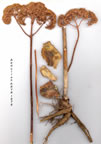| Crassulaceae |
 Sedum telephium subsp. maximum |
 Sedum telephium subsp. maximum |
| Sedum L. Sedum telephium L. subsp. maximum (L.) KROCKER Ömür: Çok yıllık Yapı: ot Hayat formu: İlk çiçeklenme zamanı: 7 Son çiçeklenme zamanı: 9 Habitat: kayalar, kuru yerler, Pinus nigra ormanları Minimum yükseklik: 0 Maksimum yükseklik: 2300 Endemik: - Element: Avrupa-Sibirya Türkiye dağılımı: KB. ve KD. Türkiye Genel dağılımı: Avrupa, Kafkasya Bulunduğu kareler: A2 A4 A8 A9 B1 B8 B9 B10 |
| S. telephium L., Sp. PL 430 (1753). subsp. maximum (L.) Krocker, Fl. Siles. 2:64 (1790). Syn: S. telephium L. var. maximum L., loc. cit. (1753); S. maximum Suter, Fl. Helv. 1:270 (1802); S. latifolium Bertol., Amoen. Ital. 366 (1819). lc: Hegi, I1I. Fl. Mittel-Eur. 4(2): t. 140 f. 1 (1921). Stout erect perennial, 30-45 cm, with simple stems; sterile shoots lacking. Leaves broadly ovate-oblong to ovate-orbicular, plane, sometimes concave, fleshy, amplexicaul, those from mid-stem 4-6 x 3-4 cm, margin obscurely crenate to subentire, alternate. Inflorescence a dense, c; 50-flowered corymb. Flowers 5-merous, pedicellate; sepals c, 1 mm, acute; petals creamy to greenish-white (in Europe rarely pink), 3-5 mm; stamens 10; follicles glabrous, erect. Fl. 7-9. Rocks, dry places, Pinus nigra forest,-S.I.-2300 m. Described from Switzerland. N.W. & N.E. Turkey. A2(E) Istanbul: Kilidjibounar, Bahçeköy, 9 ix 1900, Azn.! A4 Zonguldak: Balikisik, nr. Yenice, 150 m, D. 38012! A8 Gümüşane: Bayburt, 1500 m, Furse 3848! A9 Çoruh: nr. Ardanuç (Grossheim 4: map 318— as S. caucasicum); Kars: Yalnizçam Da,, 2100 m, D. 32552! W. of Kars, 1700 m, D. 32580! Bl Çanakkale/Balikesir: Kaz Da., 1800 m, 1968, Que'zel et al. B8Erzurum: Karakaya Da., 15 km N. of Hinis, 2200-2600 m, Watson et al. B9 Ağri: d. Suluçem, S. end of Balik G., 2300 m, D. 47287! B10 Ağri/Kars: Ağri Da. (Grossheim 4: map 318-as S. caııcasicum). Throughout Europe, Caucasia. Euro-Sib, element. Plants from N.E. Anatolia, which differ from the remainder (subsp. maximum sensu stricto) in their wider leaves (not, however, auriculate in the specimens seen), are probably referable to S. caucasicum (Grossh.) Boriss. (Fl. URSS 9:480, t. 4, 1939). None of the material seen, however, matches the type of S. caucasicum which differs in its 'cochleariform concave leaves with large auricles'. It seems doubtful if the two are specifically distinct. The remaining subspecies of S. telephium, all European, differ in having purplish-red or lilac flowers (subsp. telephium and subsp. ruprechtii Jalas) or if the flowers are greenish then the plant is smaller and procumbent (subsp. fabaria (Koch) Kirschleger). |